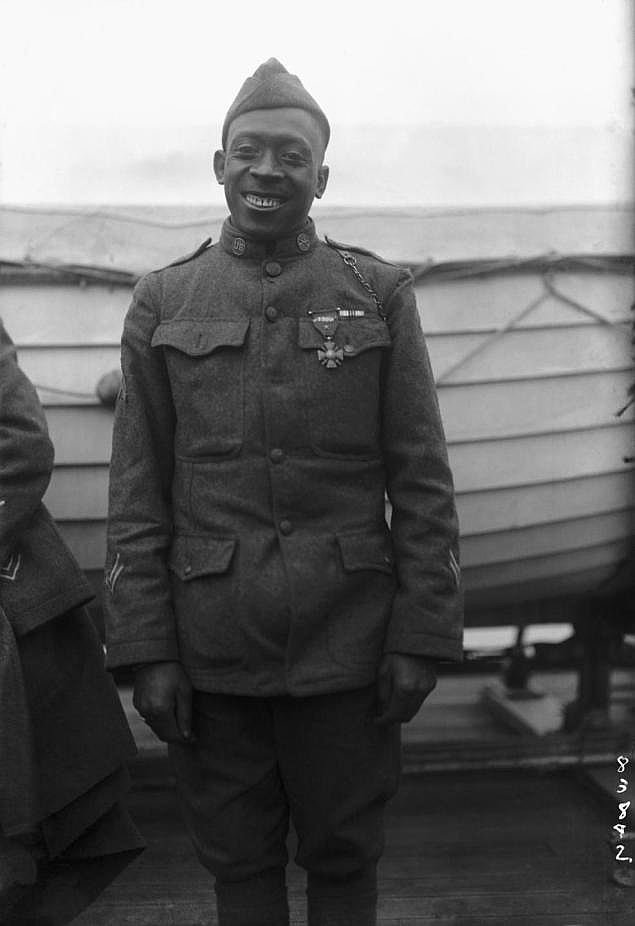During World War I, there was a fierce battle in the Argonne Forest in France on the night of May 14, 1918. Two young American soldiers were on sentry duty when about 20 German soldiers approached, hoping to catch the French and American troops unaware.
Private Needham Roberts started to return to the camp to warn the troops, but turned back in order to help his trenchmate, Sergeant Henry Johnson. Pvt. Roberts was hit with a grenade, injuring his arm and hip so that he was unable to be of much assistance in the ensuing fight. He lay in the trench giving hand grenades to Sgt. Johnson to throw at the enemy. But there were too many German soldiers, they were coming from all directions, and our heroes ran out of grenades. So Johnson used his rifle until it jammed and then he used that rifle as a club until it splintered. Then he used his bolo knife.

The bolo is a heavy 19th century blade believed to have originated from the Batangas province in Luzon, Philippines. This substantial knife has a large handle made of horn with brass fittings. The blade is heavy and well-made with a false edge on the backside of the blade. Overall length: 511 mm (20.1 inches); Blade length: 352 mm (13.9 inches); Maximum blade thickness: 7 mm (1/4 inch)
Photo Credit: Lorenz Lasco http://filhistory.com
During this fight, German soldiers were trying to capture the wounded Roberts. But when it was all over, Johnson had killed four and wounded 10-20 of the enemy before they retreated, without a prisoner. Johnson sustained over 20 injuries and spent several weeks in the hospital. His actions earned him the nickname “Black Death”.
This is not a movie script with a well-muscled and well-paid actor (or stuntman) performing choreographed moves for the camera. This was a real life hero, 5’4” and 130 pounds, twenty or twenty-one years old, desperately fighting for his life and for the life of his wounded comrade. Unfortunately, his story also lacks a Hollywood happy ending.
Henry Johnson was a member of the 369th Infantry Regiment, otherwise known as the “Harlem Hellfighters”. Because segregation did not allow them to fight alongside white American soldiers, this unit was working under French military command.
For his actions, Johnson was the first American to receive one of the highest military awards from the French, the Croix de Guerre with Gold Palm. When he returned to the U.S. he participated in a victory parade on 5th Avenue in New York City in 1919. But his military records did not reflect his injuries, so he never received the Purple Heart or disability pay. He had difficulty working due to his injuries, especially the metal plate in his foot. He did some work for the U.S. Army, traveling the country to promote war bonds and encourage recruitment.

Sergeant Henry Lincoln Johnson with his Croix de Guerre, 369th Infantry (“Harlem Hellfighters”), who single-handedly fought off a german raiding party to save his comrade, Private Needham Roberts, 1918.
Denied a pension and unable to find work, Johnson began drinking heavily and became estranged from his wife and three children. Henry Johnson died in a Veterans Administration hospital in July 1929 at the age of 32. His family assumed he had been buried in a pauper’s grave, but in 2001 his son, Herman Johnson, discovered that his father is buried in Arlington National Cemetery. More than 20 years after Johnson’s battle in the Argonne Forest, his son Herman also served in a segregated American military during World War II as one of the famed Tuskegee Airmen.
Interest in recognizing Johnson’s heroism began in the 1970s, resulting in a statue dedicated to him, and a street, charter school and postal annex that carry his name. In 1996, 78 years after being wounded, Johnson posthumously received the Purple Heart. In 2003, 85 years after his heroic actions, he posthumously received the Distinguished Service Cross, the second highest U.S. military award.
The highest American military award is the Medal of Honor, for acts of valor above and beyond the call of duty. He didn’t receive this award at the time of his actions simply because he was black. So what’s the current delay, almost a century later? What I think I understand from my research is that the voluminous required paperwork is complete and all that stands in the way is a rule that the Medal of Honor must be awarded within five years of the action for which it is being awarded.
There are currently bills in the Senate and the House of Representatives to waive this rule. Those are being included in the defense authorization bill, which Congress is voting on this week. It’ll be interesting to see what happens.


Hmm is anyone else experiencing problems with the images on this blog loading?
I’m trying to determine if its a problem on my end or if it’s the blog.
Any feedback would be greatly appreciated.
Right now it appears like Expression Engine is the best blogging platform available right now.
(from what I’ve read) Is that what you are using on your blog?
website Relationship date Married Speed Eastern two Sex ?
mobile teens Dating salonika Live busty college Dates erotic Chat
Webcam best photo Online Saarland Charm Girls Relation Free Service Affair south africa 43609